Grain Dryer Efficiency Testing
The testing of grain dryers is crucial in ensuring that agricultural machinery meets stringent quality and performance standards. Grain dryers play a vital role in the post-harvest processing of grains, helping to reduce moisture content for safe storage and transportation. This process not only extends the shelf life but also enhances grain quality by preventing spoilage and insect infestation.
The efficiency testing of grain dryers is based on several key parameters that evaluate how effectively these machines can perform their intended function. These include drying capacity, heat transfer rate, energy consumption, and drying uniformity. The test involves subjecting the dryer to a controlled environment where specific types of grains (such as corn, wheat, or soybeans) are used as specimens.
During the testing process, the grain is initially weighed and its moisture content measured. After being placed in the dryer, the temperature and airflow within the machine are meticulously monitored over time until a predetermined target moisture level is achieved. The final weight of the dried grain is recorded to calculate the efficiency ratio, which indicates how much moisture was removed relative to the initial amount.
The testing apparatus typically includes industrial-grade thermometers, flow meters for air velocity measurement, and scales calibrated specifically for agricultural materials. Compliance with international standards such as ISO 18054 ensures accuracy and reliability of results across different regions and industries.
Understanding the importance of this test is paramount for quality managers looking to maintain consistent product quality throughout their supply chain. R&D engineers benefit from detailed insights into optimizing dryer designs, while procurement teams ensure they are sourcing efficient equipment that meets regulatory requirements.
Applied Standards
| Standard | Description |
|---|---|
| ASTM D4806-19 | Determination of the rate and extent of drying in agricultural products using the forced air oven method. |
| ISO 18054:2017 | Agricultural machinery - General requirements for testing - Grain dryers. |
Industry Applications
- Agricultural cooperatives ensuring optimal drying conditions to reduce spoilage during storage.
- Farmers optimizing their harvesting practices by selecting the most efficient grain dryers available in the market.
- Government regulatory bodies enforcing standards that ensure food safety and quality across industries.
Why Choose This Test
The testing of grain dryer efficiency is essential for several reasons. Firstly, it helps in identifying any inefficiencies or potential issues within the machinery that could lead to increased operational costs and reduced productivity. By conducting regular tests, farmers can ensure their equipment operates at peak performance levels.
Secondly, compliance with international standards like ISO 18054 not only enhances safety but also builds consumer trust in the products being produced. This is particularly important given the global nature of food trade and increasing demands for transparency from consumers regarding how agricultural products are processed.
In addition to these benefits, efficient grain drying contributes significantly towards sustainable farming practices by minimizing waste and maximizing resource utilization. For R&D engineers involved in developing new technologies or improving existing ones, understanding exactly where improvements can be made through detailed testing results is invaluable.





